From 4–8 October, the Dreiländertagung meeting was held at the Kursaal centre in Bern, Switzerland. Taking place every three years, the German-speaking meeting brings together the German, Austrian and Swiss vascular societies to discuss innovation, research and practice in German-speaking Europe. With so many eminent physicians in attendance, Vascular News took the opportunity to discuss some of the questions currently facing German-speaking, and European, medical practice, education and cooperation.
Peripheral intervention
Iris Baumgartner, Bern, Switzerland
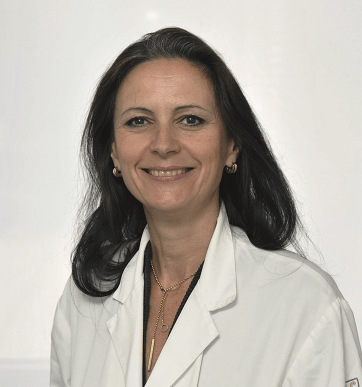
For critical limb ischaemia, is endovascular treatment always preferable to bypass?
IB: An “endovascular first” approach is the best method. However, I refuse to put the word “always” before it, as nothing in medicine or surgery is “always” the best option. There is a subset of patients we can only treat with surgery—those with long occlusions or very calcified long-standing occlusions that you cannot pass with a wire and a catheter—so there are cases that need to be discussed with an interdisciplinary and complementary approach. It is all about finding the best fit for each particular patient. It is like antibiotics; it is not a question of one versus the other. It depends on the situation and you need to adapt what you do to the situation and the pathology of each patient. I try to make the point that if specialities work closer together, surgeons can learn endovascular methods. The surgeons feel that endovascular methods are endovascular only, but there is a high level of skill that you must reach if you really want to prevent amputation and critical limb ischaemia.
Do we know the maximum length of lesions that we can treat with drug-coated balloons?
IB: Some claims about treating long lesions are based on subgroup analysis that I am not totally sure about, as the study designs are not usually geared towards studying long lesions. I am very careful in my statements about how far we can go with drug-coated balloons, as we do not have real robust evidence for it. If you can conduct a carefully designed randomised controlled trial with core lab adjudication and an appropriate number of patients, the result is completely different to single-centre, non-core lab adjudicated wishful thinking. For me, there are cases where we still have to do bypass surgery; there is no conclusion whether we have to stent them all, whether we have to go with debulking or whether we have to go with covered stent grafts. There was a recent randomised controlled trial in the USA by John Laird showing that for long lesions, stenting versus covered stenting showed no difference.
When it comes to skill and competence for the interventionalist and the surgeon, everybody is doing everything, and that dilutes expertise. I favour what I call “restricted competence”—I believe in doing one or the other at a high level, but not both.
The Swiss Society for Vascular Surgery and interdisciplinary cooperation
Mario Lachat, Zurich, Switzerland
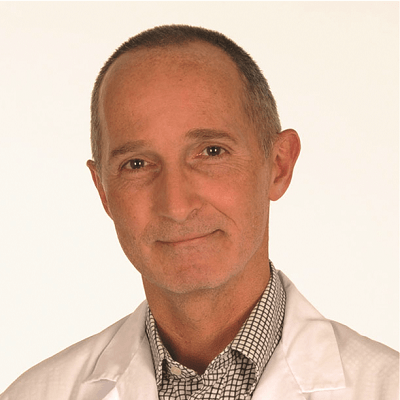
Can you tell us about the relationship between the German, Austrian and Swiss vascular societies?
ML: There is a very close working relationship between these three German-speaking countries. The specialities are quite similar and they all approach vascular medicine in a similar way with the same philosophy. Together, the societies represent a lot of people, including the angiologist, the vascular surgeon, the cardiac surgeon, the general surgeon and the radiologist.
In Switzerland we started to establish certification of vascular centres, and the basic structure is to have vascular centres, the angiologist and the radiologist all together. This gives us the option of different views on patient care and gives a more balanced approach.
Why is inter-society collaboration important?
ML: There are so many small specialities in medicine, and I think this is something which will continue to be true in the future. I think it is important that we keep connections with different societies. We need to be included in a common setting, but we must take great care—I can see this in the field. In my time, medical training was broader and longer. Now, the students will go into a specialty very early, so a lot of translational and trans-speciality knowledge is lost. The general physician will now ask for advice from lots of people with small areas of speciality—the wider view of patient management is somewhat lost. Although the outcomes of pathology treatment have generally become better, I am not sure that outcomes for the patient as a human being has improved.
In Europe we should be able to have a level that is uniform and a shared culture of education. I have visited a lot of hospitals, and the standard varies from high to low, but the people behind the care are similar in their dedication; every country has its habits and cultures. Having common international societies is key for scientific, education and political purposes.
How would you like treatment approaches to evolve?
ML: I would like to see teams that work together dedicated to treatment. Let me try to explain what I mean. In Zurich, for example, there are three great groups of hospital, with the people working together in each one different, and the relative representation of each speciality varying, be they angiologists, cardiologists or vascular surgeons. The vascular surgeon cannot work alone. The specific discipline is secondary to the integration of various skills in the patient’s interest.
Training and academia; the German Society for Vascular Surgery and Vascular Medicine
Thomas Schmitz-Rixen, Frankfurt, Germany, and German Society for Vascular Surgery incoming President
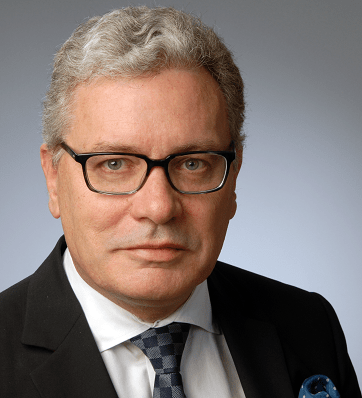
Can you tell us about the recent development of the German Society for Vascular Surgery?
SR: The Society now has approximately 2,600 members, with an annual growth of 8% in recent years. The annual meetings bring in approximately 1,500–2,000 people.
For a long time in Germany, we had to battle to become an independent speciality—the founding aim of our society. Now that this has been achieved, we must consolidate and make our contribution visible to all other specialities. Compared to other specialities, vascular surgery was often seen as difficult and not very lucrative work, working on aneurysms and rotten feet—we need to continue to change this perception.
Another goal of ours is to centralise vascular aneurysm surgery. General surgeons are still performing a lot of vascular surgery, and currently approximately one quarter of aneurysm surgery is done in hospitals that are performing fewer than five cases each year.
In Germany, how can you be certain that patients will have properly trained surgeons for elective aneurysm surgery?
SR: We do a lot in the Society to ensure treatment standards. We have a teaching academy where we offer courses on endovascular and open work, and we have another institute—the German Institute for Vascular Public Health—where we have a quality assurance programme for the treatment of abdominal aortic aneurysms, in which approximately 30% of the announcements in Germany are done going into that. I am also the chief executive officer of that Institute.
Now we have to get our young people to the same level and continue the work we have already achieved. Our attitude is that we have to make sure the young doctors following us have the right attitude and foster what we have started. It is very important to combine academic surgery with routine surgery—they cannot and should not be separated. Everyone has to keep an interest in basic science and clinical research, which is why I am still active in that.
How can we combat the ongoing dilatation process for aneurysmal disease?
SR: We have to find a basic science mechanism that will interfere with this dilatation and limit it; this can only be a drug. So far, outcomes have been disappointing. Understanding enzymes and their activity is not the same as preventing the disease processes. I published a paper this year in Langenbeck’s Archives of Surgery, and I put together all the information we have on biological, biomechanical and biochemical processes, rupture and growth of aneurysms. It is a huge amount of data, and though we have lots of information, there are missing links and we do not understand the basic mechanism of growth. We have to work on that. There is great hope at the moment around looking into, for example, microRNA which can be detected in the blood, because they are regulators of every process in our body.
The European Society of Vascular Surgery at Dreiländertagung
Sebastian Debus, Hamburg, Germany, and Jürg Schmidli, Bern, Switzerland
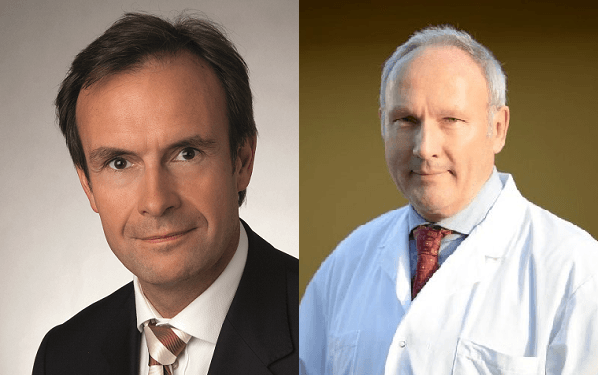
What does the future hold for the ESVS?
SD: We have developed a clear vision for the future of ESVS. In Copenhagen we had a great spirit. I have the impression that ESVS is alive; people are active, friendly and acting like a family. This is good news for our members and for the Society itself.
In terms of the future, I think we need to cover more than exclusively science; we need to cover training. We should represent the best of training in the future. For this reason, we had a lot of discussions about developing the ESVS meeting into an ESVS vascular week, covering science and a large training programme, as well as state-of-the-art lectures looking at what we know now that we did know a year previously. I think we need some points of identification, which we identified with the Volodos lecture this year; Ross Naylor gave a great lecture and received a standing ovation, showing a great confidence in the Society. I am very confident about the development of the Society. Finances will come back and industry support is coming back; they need to be part of the Society in our eyes. We have common sense in out executive committee and this is a very good prerequisite to achieve what we want to.
How has the Society changed in recent years?
JS: The Society had a steady decline in attractiveness for some years. We made some mistakes and I think that we reached a low point the year of the Stockholm 2013 meeting. At this time, we failed to talk sufficiently with industry and only sent administrators to talk to them. More recently we have involved management in liaising with industry, and relationships have improved. Porto in 2015 was an improvement on Stockholm, and now Copenhagen 2016 was a great meeting, with a record number of abstracts; a sign that people are again interested in the Society. We saw a lot of smiling faces and, as Sebastian said, a great spirit, and we have already started meetings with physicians and industry about future meetings.
We will also have a new post—Deputy President Elect. We will have two President Elects, so we have even more people that can be involved in further meetings. The role of Immediate Past President will disappear in two years—we will have a three year rotation—Deputy President Elect, President Elect and President.
SD: The reason behind this is that, formerly, the Past Presidents were not able to actively engage themselves in inventing new visions. They actually stopped being active with the end of their Presidency, which is the same in other societies. With this change, we will give them three active years to follow and introduce their visions.
How successful is the Dreiländertagung’s three-year rotation between Germany, Austria and Switzerland?
SD: I am a strong supporter of the Dreiländertagung meetings and the three-year cycle, because we can learn so much from each other. We can see how vascular surgery is managed in the different countries, and having these close discussions without language borders is a great achievement; we are both very keen to keep this going in the future. I was personally responsible for the Berlin Dreiländertagung in 2010, which was a success and it was very nice to have the meeting in Berlin with the title “Crossing borders”. We had the second meeting in Linz which was also very good. Now in Bern, we can see the great benefit for all the attendees to have this close contact with their German-speaking colleagues. It is a platform to create friendships, to create relationships for science, clinical trials and even education and visiting other centres; we should actively make use of these opportunities.
Approaching the problem of aortic dissection
Dittmar Böckler, Heidelberg, Germany, and Tilo Kölbel, Hamburg, Germany
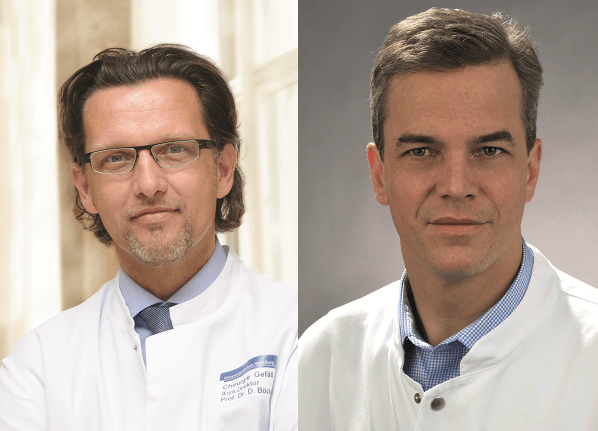
Are the current definitions of type A and B dissections correct and/or useful?
DB: No. I think that type A and B definitions are too general. Type A is when the entry site is in the ascending, and type B is when it is distal to the subclavian, although there is an overlap between the two. The same as the type B having a false lumen or thrombotic intramural haematoma retrograde to the ascending into the arch, also a different story; A and B is just a physiological classification.
TK: I think it is still a very useful classification. It is anatomical, but the main use is as a practical classification; it tells everybody in the emergency room that type A has to be primarily referred to cardiac surgery, and type B should be primarily referred to vascular surgery.
DB: I agree with Tilo that it is still useful, but it is not the future. In the future it will not be about cardiac surgery and vascular surgery, we will be treating patients together. We have different tools to treat; we have imaging in the operating room, and now it does not come back to a triage of cardiac or vascular depending on the entry site.
How are the dissections classified as acute, sub-acute and chronic?
DB: Acute is less than 14 days, sub-acute is between 14 days and six weeks, and everything after that is chronic. However, development of these criteria is an ongoing process. I think that the classification of acute and sub-acute is not so useful anymore; we need a new classification.
TK: You will also find the number of 15–90 days used in some literature for sub-acute, while it is 15–30 days for some others, although this probably does not make a lot of difference in practice.
Can you explain how you differentiate between complicated and uncomplicated dissections?
TK: Complication is either malperfusion of any organ of any sort, or rupture or early dilatation.
DB: I agree that malperfusion and rupture is clear, but acute and rapid dilatation in the first 14 days is very sudden. At the start of my practice, I did not accept it, but now I do accept that there are patients being untreatable for pain and hypertension, so for me these are also complicated cases.
How important are advanced imaging techniques such as 3D MR imaging in deciding whether to intervene?
TK: For me it is not hugely important. We see a lot of nice images from 3D imaging, but it then takes a long time to reach a consensus on how to translate this information from advanced imaging to clinical practice. One thing I think we should be looking at more is the role of risk factors and the combination of risk factors. This would get us to a risk score for complicated and uncomplicated patients.
DB: Image-based predictors are quite reliable and very well published, and there is even proof that they reduce mortality. There needs to be a standardised, internationally-accepted CT protocol, wherein everybody has the same criteria of applying CT. CT because it is available around the clock all around the world; MR is more sophisticated but also more expensive, takes longer and is not always available in an emergency.













